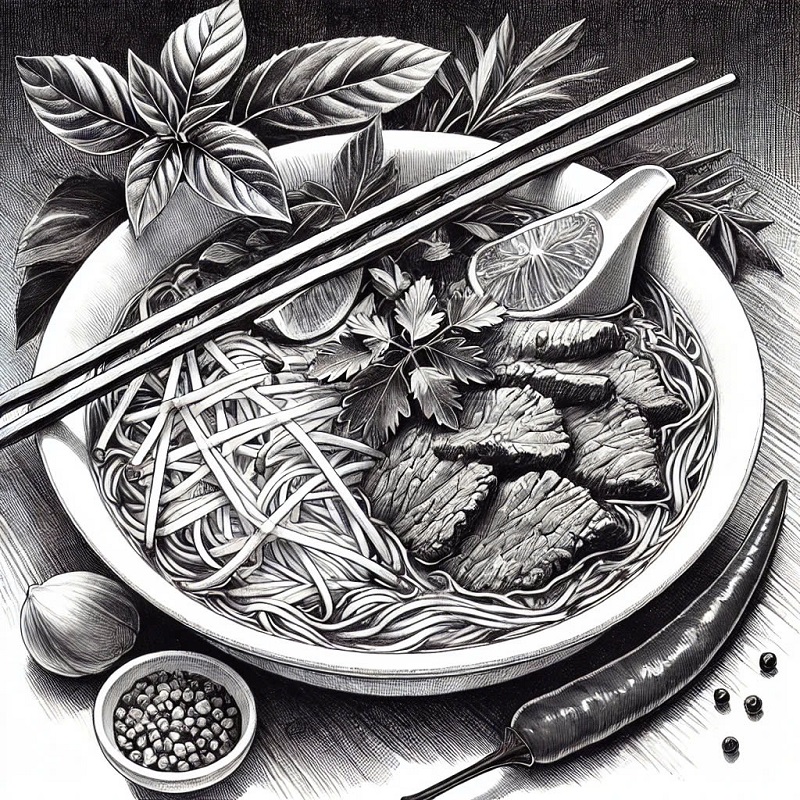Why is Hanoi beef noodle so famous?
The best dish in the city is undoubtedly Hanoi beef noodles. Trying to capture the spirit of the Hanoians through their recipes is worth the effort.
One of the three dishes officially declared as part of Vietnam's intangible cultural heritage was Hanoi's pho bo, or beef noodles, last week. In today's The Hanoi Times Words on the Street feature, we explore a personal viewpoint on the reasons for this dish's rising fame.
Vietnam boasts a rich and varied culinary culture, with distinct specialties found in each of its regions and provinces. These gastronomic marvels come together in big cities, especially Hanoi.
Thang Long - Hanoi has developed over the course of a millennium to become a hub where the quintessence of nature, culture and arts from across the country converge. Among its many offerings, pho bo has emerged as one of the capital's iconic dishes, distinguished by its unique soul and irresistible allure.
Based on available data, Hanoi presently has around 700 restaurants that specialize on serving pho bo. The majority of these are found in downtown neighborhoods in Cau Giay, Hoan Kiem, Ba Dinh, Dong Da, Thanh Xuan, Hai Ba Trung, and Long Bien districts.
Some well-known pho brands include Pho Thin Lo Duc (beef noodle originating from Lo Duc Street), Pho man Gam Cau (salty noodle), and Pho Ly Quoc Su (beef noodle originating from Ly Quoc Su Street). Besides these famous chains, lots of family-run eateries and street vendors also offer their own versions of this treat.
The broth, which is painstakingly crafted with beef bones, ginger, charred onions, cinnamon, star anise, black cardamom, and other seasonings, is what makes Hanoi pho bo so special. Each business uses a proprietary formula to precisely balance and add these ingredients at just the right time. The broth is simmered for an entire day, skimming off impurities to extract the purest flavors, then seasoned with salt and other spices.
The unique flavor of Hanoi pho bo is derived from the intricacy of the cooking and preparation procedure. The natural herbs in the broth give it a pleasant scent without the overpowering taste of fish sauce or the strong aroma of beef bones.
Over the course of their careers, several of my colleagues have visited different parts of the country and tried various versions of pho. They all concur, though, that Hanoi pho is the best.
Although this may come out as personal, there's a good reason why almost every traveler to Vietnam is itching to sample Hanoi pho. In their travels through Vietnam, foreign visitors frequently consider Hanoi pho bo to be one of the must-try foods.
In fact, Hanoi pho bo epitomizes the grace and sophistication of a historic capital with a millennia-old cultural legacy. A bowl of Hanoi pho bo conjures up images of the elegance and manners of bygone Hanoi for a lot of diners. This dish has consistently been listed as one of the most appetizing and delectable foods on the planet.
Hanoi pho bo is known for its subtle flavor that lingers on the palate long after eating, according to culinary artisan Pham Thi Anh Tuyet. The seasoning is perfectly balanced, neither too strong nor too mild. The pho noodles are thin, delicate, and chewy, while the tender beef slices blend harmoniously with the noodles, occasionally accented by the gentle heat of ginger and the spicy blast of fresh chili.
Many experts believe that Hanoi pho bo is ideally suited to become Vietnam’s global culinary heritage, precisely because of its refinement and elegance in preparation and cooking.
Pointless debate?
Alongside Hanoi pho bo, Nam Dinh pho bo has also been listed as a national heritage dish. Currently, a debate is raging on social media and among the general public about which pho truly deserves to represent Vietnam on the world stage.
It’s weird that people would argue over something that’s not a matter of true or false. Here, it really comes down to personal preference.
As someone with roots in both Hanoi and Nam Dinh, I find it difficult to choose which pho is superior. Since I personally love both Hanoi and Nam Dinh pho, I don't mind if they both get listed in the world culinary map.
However, one obvious advantage Hanoi has is its ability to promote its culinary culture. In the first six months of this year, Hanoi welcomed over 16.4 million tourists, an increase of 11.8% compared to the same period last year. International tourists surged by 42.5%, reaching over 3.4 million.
Conversely, Nam Dinh’s tourism industry still falls short. Despite its many attractive destinations and a promising service sector, the province has yet to make the most of these strengths to develop tourism and bring attention to its pho.
In the first quarter, Nam Dinh received only 715,000 visitors, even though it hosted two major cultural events: the Tran Temple Festival (held on the 14th-15th of the lunar calendar) and the Pho Festival 2024 (from March 15-17).
About two weeks ago, I had the opportunity to visit Hai Hau, Nam Dinh with my family. This area was once a popular destination, but now, there are few visitors, and the local businesses are barely getting by.
Nam Dinh needs to take concrete actions to develop its tourism. Only by doing so can the province attract visitors and make Nam Dinh pho bo a memorable dish for tourists.
It’s pointless to argue over whether Hanoi or Nam Dinh pho bo is better. Instead, we should focus on elevating these dishes and launching marketing campaigns to draw more diners in.












